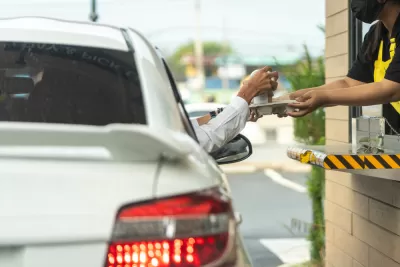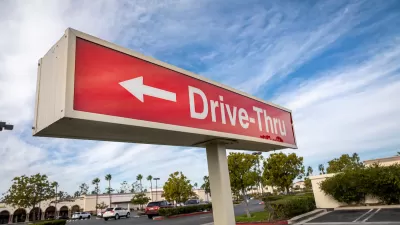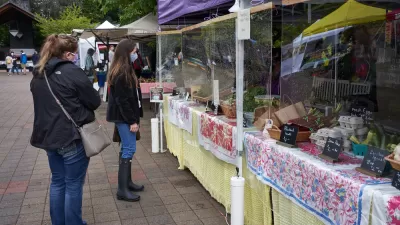Responding to pandemic-era shifts in customer demand, fast food and fast-casual chains are stripping away dining rooms, restrooms, and human cashiers in favor of drive-through and automated pickup options.

“Pushed by pandemic restrictions and pulled by the increasing ease of mobile transactions, customers have rushed into drive-thrus, delivery, and mobile ordering.” Consequently, writes Henry Grabar in Slate, most American fast food chains are opening “digital kitchens” with no indoor seating or in-person transactions. Emma Beckett, an editor at Restaurant Dive, says in addition to innovative new designs for new stores, “the arms race is on to remodel older stores with drive-thru lanes.”
Some chains are shifting to ‘ghost kitchens:’ “unmapped, closed-door facilities where food for delivery might be prepared for a dozen different brands at once.” In general, Americans are buying more prepared food than ever, with restaurant spending surpassing grocery spending for the first time in the 2010s.
Breakfast spending at coffee chains like Starbucks is the fastest-growing segment of the shift to eating out. “Despite its roots as an urban gathering place whose comfy chairs, Wi-Fi, and bathrooms invite customers to linger, on-and-off closures related to COVID have helped accelerate a business shift toward mobile, delivery, and drive-thru, which now make up almost three quarters of the brand’s U.S. revenue.”
“It’s not just mobile apps that are making these changes attractive, but an older technology that also promised both freedom and a kind of anti-social isolation: the automobile.” And with remote work making it possible to eat at home rather than in the office or on the go, it’s possible that, when it comes to where Americans want to spend their time, “nothing beats the kitchen table.”
FULL STORY: Take Your Fries and Leave

Alabama: Trump Terminates Settlements for Black Communities Harmed By Raw Sewage
Trump deemed the landmark civil rights agreement “illegal DEI and environmental justice policy.”

Planetizen Federal Action Tracker
A weekly monitor of how Trump’s orders and actions are impacting planners and planning in America.

The 120 Year Old Tiny Home Villages That Sheltered San Francisco’s Earthquake Refugees
More than a century ago, San Francisco mobilized to house thousands of residents displaced by the 1906 earthquake. Could their strategy offer a model for the present?

Opinion: California’s SB 79 Would Improve Housing Affordability and Transit Access
A proposed bill would legalize transit-oriented development statewide.

Record Temperatures Prompt Push for Environmental Justice Bills
Nevada legislators are proposing laws that would mandate heat mitigation measures to protect residents from the impacts of extreme heat.

Downtown Pittsburgh Set to Gain 1,300 New Housing Units
Pittsburgh’s office buildings, many of which date back to the early 20th century, are prime candidates for conversion to housing.
Urban Design for Planners 1: Software Tools
This six-course series explores essential urban design concepts using open source software and equips planners with the tools they need to participate fully in the urban design process.
Planning for Universal Design
Learn the tools for implementing Universal Design in planning regulations.
Clanton & Associates, Inc.
Jessamine County Fiscal Court
Institute for Housing and Urban Development Studies (IHS)
City of Grandview
Harvard GSD Executive Education
Toledo-Lucas County Plan Commissions
Salt Lake City
NYU Wagner Graduate School of Public Service





























